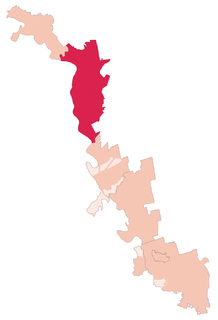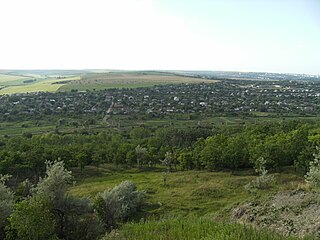
Tiraspol is the capital of Transnistria, a breakaway state in Moldova, where it is the second largest city. The city is located on the eastern bank of the Dniester River. Tiraspol is a regional hub of light industry, such as furniture and electrical goods production.

Transnistria, officially the Pridnestrovian Moldavian Republic (PMR), is a breakaway state in the narrow strip of land between the river Dniester and the Ukrainian border that is internationally recognized as part of Moldova. Its capital is Tiraspol. Transnistria has been recognised only by three other mostly unrecognised breakaway states: Abkhazia, Artsakh, and South Ossetia.

Camenca is a town in Transnistria, a breakaway republic internationally recognized as part of Moldova. It is composed of the town itself and the village of Solnecinoe. Camenca is the seat of Camenca District.

Rîbnița or Rybnitsa is a town in Transnistria in Moldova. According to the 2004 census, it has a population of 53,648. Rîbnița is situated in the northern half of Transnistria, on the left bank of the Dniester, and is separated from the river by a concrete dam. The town is the seat of the Rîbnița District.

Grigoriopol is a town in Transnistria autonomous territorial unit, Moldova. It is the seat of the Grigoriopol District of Transnistria. The city is located on the left (eastern) bank of the river Dniester at 47°09′N29°18′E, in central Transnistria. Grigoriopol is composed of the city itself, and a small village Crasnoe (Красное). The town itself had a population of 11,473 in 2004.

The Rîbnița District is an administrative district of Transnistria in Moldova. Its seat is the city of Rîbnița, sometimes spelt as "Râbnița". It is located at 47°45′N29°00′E. The district contains this city and 22 other communes :

Camenca District is a district of Transnistria, a breakaway republic which is internationally recognized as part of Moldova. Its seat is the town of Camenca. The district contains this town and twelve communes :

Dubăsari District, is an administrative subdivision of Transnistria, Moldova. It is located along the river Dniester, in the center of Transnsitria. Its seat is the city of Dubăsari. The district contains this city and 9 communes :

Slobozia District is a district of Transnistria. It is the southernmost district of Transnistria, located mostly south of Tiraspol. Its seat is the city of Slobozia, located at 46°44′N29°42′E, on the river Dniester. The district contains 4 cities/towns and 12 communes :

Gîsca is a village near in Căușeni District, Moldova, composed of a single village with the same name, population 4,841 at the 2004 Census. The locality, although situated on the right (western) bank of the river Dniester, immediately to the south-west of the city of Tighina (Bender), in the Bessarabian, not Transnistrian part of Moldova, is under the control of the breakaway Transnistrian authorities.

A demographic history of Transnistria shows that Transnistria has been home to numerous ethnic groups, in varying proportions, over time.

Cobasna is a commune in northern Transnistria, Moldova that is composed of three villages: Cobasna, Cobasna station, and Suhaia Rîbnița. It is controlled by the authorities of Transnistria. It is located 2 km from the border with Ukraine, in Rîbnița District. Cobasna is the site of a Russian, and formerly Soviet ammunition depot, one of the largest of its kind in Europe.

Maiac is an urban settlement, or city in the Grigoriopol District, Transnistria, Moldova, 11 km northeast of Grigoriopol, on the Ukrainian border.
Armenians in Moldova are the ethnic Armenians that live in Moldova. They settled in the Principality of Moldavia since the Late Middle Ages, and were well known as a merchant community. They prospered, and built a number of Armenian churches. Since the 18th century, however, their numbers decreased due to assimilation and emigration to other countries. During Soviet occupation, the number of Armenians increased a little, both during the 1950s-1980s, and when new immigrants came from Armenia, Azerbaijan during First Nagorno-Karabakh War in late 1980s. But after the fall of the Soviet Union, it decreased again.

Bîcioc is a commune in the Grigoriopol District of Transnistria, Moldova. It is composed of two villages, Bîcioc and Novovladimirovca (Нововладимировка). It is currently under the administration of the breakaway government of the Transnistrian Moldovan Republic.

Butor is a commune in the Grigoriopol District of Transnistria, Moldova. It is composed of two villages, Butor and India (Индия). It is currently under the administration of the breakaway government of the Transnistrian Moldovan Republic.

Colosova is a commune in the Grigoriopol District of Transnistria, Moldova. It is composed of three villages: Colosova, Crasnaia Besarabia and Pobeda. It is currently under the administration of the breakaway government of the Transnistrian Moldovan Republic. The village of Colosova was part of the Glückstal Colonies, known during the 19th Century as Bergdorf and inhabited by Germans farmers.

Carmanova is a commune in the Grigoriopol District of Transnistria, Moldova. It is composed of four villages: Carmanova, Cotovca, Fedoseevca and Mocearovca. It is currently under the administration of the breakaway government of the Transnistrian Moldovan Republic.

Crasnencoe is a commune in the Rîbnița District of Transnistria, Moldova. It is composed of three villages: Crasnencoe, Dimitrova and Ivanovca. It has since 1990 been administered as a part of the self-proclaimed Pridnestrovian Moldavian Republic (PMR).

The Pridnestrovian Moldavian Republic is subdivided into five raions :














